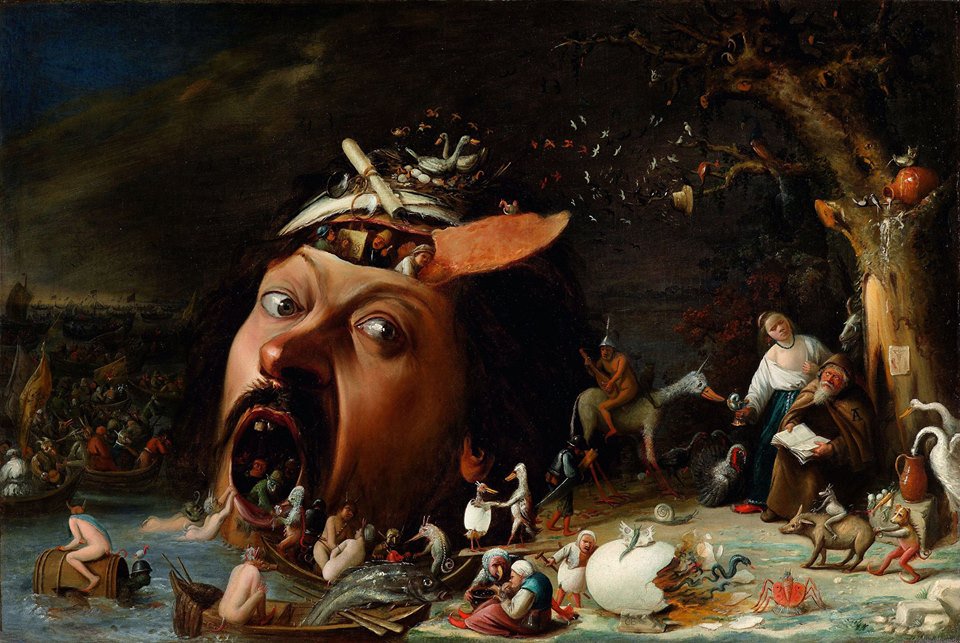
Ante Scriptum: I wrote this post long ago, before even this
art-mirrors project formally commenced. It wasn’t even written about
mirrors per se, but to comment on another posting, about the
re-interpretations of the Diego Velázquez’
Meninas (you can find it here too, see
Contemplating reinterpretations).
When transferring it here, I decided not to edit it too much, and
leave as is, even though today I would write it differently.
To start, let’s have a look at the painting itself:
It’s a stunningly famous work of art, I bet it is in the top ten
most recognisable paintings in the world. As often happens in such
cases, it makes the task of writing about it both difficult and easy.
The easy part is that one shouldn’t really write about it at all, or at
least can skip the ‘basics’, and this knowledge about the years of
creation, the sizes, and plot, the heroes, and who are the maids, and
why the cap is read etc etc. In case you don’t know all that and really
want to, the
wikipedia is all yours.
The difficult part is, of course, related to the
tremendous popularity of this painting. This work is not just
over-researched, it’s hyper-over-research, the only bibliography of
‘serious’ publications about Las Meninas already comprises a relatively
large book. And it is hugely popular both among artists (and art
critics) and more theoretical folks, like historians and philosophers.
Michel Foucault in the first chapter of his
Les mots et les choses (1966)
made a claim that this is THE most important, pivotal work for the
European civilisation that reflects (sic!) the very formation of modern
identity, and modern way of thinking about and perceiving the world (and
us as a part of this world).
According to Foucault, Velázquez was the first who employed this
clever trick, of putting us, the viewers, into the place in front of
this painting in such a way that we inevitably understand that this is
the very position where the kind and the queen are standing. In this way
we are becoming the kind and the queen, and
theVelázquez-in-the-painting is actually painting us on his
canvas-in-the-painting.
Few years later this argument was support by
John Searle,
a renown American philosopher, who suggested that the painting
(re)presents, in a paradoxical way yet very accurate way, how we
perceive this world and at the same time what can be (re)presented by
art – see his paper
Las Meninas and the Paradox of Pictorial Representation (1980)
[
pdf].
However, Searle believes that if would be able to look at the
canvas-in-the-painting, we would see not the king and queen (or us), but
this very
Las Meninas! It is interesting how all these complex
debates can be distilled to a very simple issues, of what is actually
depicted on that canvas-in-the-painting.
The classical version (also endorsed by Foucault) says that what we see is a moment of sitting, of the Spanish king
Philip IV and his wife,
Mariana of Austria,
for their joint portrait, to be painted by Diego Velázquez, the court
painter. The session is interrupted by the visit of their daughter,
infanta
Margaret Theresa,
who entered the room with her entourage of the maids (=meninas). John
Searle obviously suggests a more paradoxical version, but still within a
framework of ‘pictorial representations’, as they call it in the
art-speak.
Few years later
Joel Snyder,
Professor of the Chicago University and a research of perception
(including of art), has published his critical response to the above
argument, in the paper titled
Las Meninas and the Mirror of the Prince (it
used to be online in full, but now I see only the first page). His
reply can be also called hyper-critical, as he basically levels to the
very ground all the arguments of Foucault-Searle (and to my taste in a
very mordant style; they try to avoid such style these days).
Basically, Snyder sees nothing ‘paradoxical’ in this painting (and in
general is against applying this term to art, suggesting instead to use
‘peculiar’ or simply ‘strange’). Some, but not all, drawings by Escher
are deliberately paradoxical, yet there is nothing ‘paradoxical’ about
Las Meninas.
There is no such things as the ‘placement of the viewer into the shoes
of the king’, alluded by Foucault or any other similar ‘games of
perception’.
According to Snyder, if we would carefully reconstruct the room in
its entirety, we would easily find a spot where we could stand and
observe this scene, of the painter making the portrait of the royal
couple. We are not the ‘king and queen’ here, but the visitors who
actually intruded the scene (and thus everybody looks at us with a
certain bewilderment.)
<tangent >
I always see all these perspective reconstructions of this painting
with a great deal of scepticism – if only because the original painting
was of very different size, unknown to us now. What we know is that it
was much bigger (wider), but it was damaged by the fire in a royal
palace, and this damaged part was simply cut off. Later it was also
moved from one room to another, and cut again, most likely from the
right size. Knowing that, all these contemporary reconstruction in
search of the magical ‘points of viewing’ are no more than wishful
thinking.
Above is one of the versions of the original painting constructed by Eve Sussman, who later also made a short movie (
89 Second in Alcazar)
reenacting this famous scene in the royal palace. Sussman also assumes
that the painting was much larger (the red square is what we have left
today).
However, this reconstruction is no better – or worse – that any
others, and without the exact data on the original sizes any theoretical
constructions remain to be sortilege of a kind.
</tangent >
But Synder went even further, acting now not so much as a researcher
of perception, but a researcher of (art) history. He actually argues
that Velázquez-in-the-painting paints nothing, i.e., there was no
‘portrait’ of the king and queen intended. What he is making is yet
another portrait of the young infanta, commissioned by the king, and as
with any other portraits of her, before and after that, he is loading it
with a certain
morality.
In this case, Velázquez is exploiting a certain play of words (and meaning) which Snyders analyses in details.
Let’s take the front page of the book that was very well-known back then in Spain, so called
Idea de un principe politico cristiano, by some Diego de Saavedra Fajardo. We see that instead of canvas it depicts a mirror.

The issue is that another, better known title of this boos was ‘
The Mirror of the Christian Politician (Ruler)‘,
whereby the word ‘mirror’ was used with a meaning of a ‘codex’ or a
‘corpus (of laws)’. This was not that only book of such sort, of course.
In fact, there was a large assortment of various ‘mirrors’ at that
time, such as ‘The Mirror of a True Gentleman’ or ‘The Mirror of
Respectable Husband’ and so on.
Below, for example, is a front page of the‘The Mariner’s Mirror’ (1588) written by
Lucas Jansz Waghenaer, famous Flemish explorer and cartographer.
Basically, Snyder argues that the ‘mirror’ we see on the painting is
not more than an allusion to this meaning of the word, and thus the
purpose of the work was to depict the infant with a mirror, in other
words, with the admonishment of the king to his daughter.
Velázquez panted numerous portraits of the infanta, depicting her
different ages (and I compiled only a few of them in the collage I
started this posting with). Many of them indeed have similar symbolic
messages. For instance, the fan on the left painting below signified a
certain age (and the status) she reached, after which she had to point
to the objects only by such fan, not by hand. The painting with the
globe shown on a background of another portrait was to signal the start
of more serious studies she had to go through (but of course also
manifested the vase Spanish possessions of land in Latin America).
 |
 |
This last portrait is also an example of another theme, of motif of
the Velázquez’ oeuvre, namely ‘Painting in the painting’. I think it’s a
very important element of his art, and largely unnoticed (or at least I
never read any detailed analysis of this topic). To comment on this,
albeit very briefly, I have to start from his earlier works (per se
having nothing to do with the mirrors).
Below is a typical work of early Velázquez, made in the so called
bodegón genre
(from
Spanish ‘bodega’, a tavern or a wine cellar); appropriately, it depicts
lots of food stuff and kitchen utensils (the official title of the
painting is ‘
Old Woman Frying Eggs‘, 1618):
He made a number of such works, and they were all of good quality,
but also were not able to bring neither fame nor income; the latter two
were given for either religious work or portraits of nobility. I think
Velázquez found an interesting bridge between these worlds and the
subjects more familiar to him.
Here is also one of his earlier paintings, so called
Christ in the House of Mary and Martha (c.1620):
At the first look, this is a very simple illustration of the famous
story from the Bible, about pragmatic Martha and devotional Mary (not
the Saint Mary, though). Yet the painting contains a puzzle, of what is
actually depicted in its upper left corner. Is it a painting? a door?
or, perhaps, a mirror?
But before even answering this question, the very depiction of the
figure of Christ was transferring this otherwise simple bodegon into a
symbolic art-work, thus also elevating its author on a higher
professional level (or so I think).
The latter version, about mirror, is very unlikely, of course,
because the mirrors of such size were very rare and VERY expensive back
then (and under ‘back then’ I mean the times of Velázquez, not Jesus
Christ). One wouldn’t expect to see in the house of modestly living
family of Martha and Mary.
Interestingly, though, this version was quite popular at some point,
partly because the conditions of the painting. It was getting darker
with time, but the restoration efforts mostly meant cleaning certain
areas by saliva, so with time the area with Christ became the brightest
spot, while the frame turned to be into one dark area.
When the painting was restored, it became obvious that depicted is
the painting on a wall. However, as a more careful analysis with the use
of X-rays revealed, Velázquez perhaps intended to make it a ‘door’; the
lower part of frame appeared much later during the process.
Either way, what we see here is a trick employed by some painters,
namely depicting a picture inside a painting. Velázquez used the same
trick in another work of about same time,
Kitchen Maid with the Supper at Emmaus (с. 1620)
Soon after Velázquez will travel to Madrid, and soon propelled into
the court painter. His tremendously quick take-off is mostly due to his
talents and skills, of course, but also the result of multiple
serendipitous circumstances (right-time-right-place kind of things; he
came to Madrid in March 1622, and in December of this year the previous
court’s painter suddenly died, being relatively young by then.)
He painted a portrait of his first patron in Madrid, Don Juan de
Fonseca, who liked it, and who showed to the king. A portrait of the
king was commissioned, and was completed basically within one day, after
just one sitting, in August 1623. Apparently, Philip liked it so much
that he ordered to withdraw from circulation all the previous painting
of him and granted to DiegoVelázquez and exclusive right to paint the
king, together with a position of the new court painter, the position he
officially took from 1624. In less than two years Velázquez made a
journey from an unknown master to the painter of the mightiest
monarch of that time, simples.
Velázquez will paint numerous portraits of the king, and later his
family, as well as portraits of nobility. His style will be gradually
becoming more gentle, compared to the stiff and sober manner of his
earlier works, and also inevitably more pompous (though he will never
reach the grandiosity of Rubens, very fortunately). Interestingly, but
he met Rubens who came to Madrid in 1928, at the peak of his fame,
though the latter didn’t have much influence on still quite young Diego
Velázquez.
Rubens, however, has made on the fate of the Spanish court painter,
as it was most likely him who finally persuaded Velázquez to travel to
Italy, to learn about, and from Italian art. Diego Velázquez spent
almost a year and a half in Italy, and came back to Spain a very
different painter; art historian often divided his works on two periods,
‘Before Italy’ and ‘After Italy’.
One major difference is a much better understanding of human anatomy,
that Velázquez could learn both from the famous works of art but also
from the real (nude) models, the opportunity he was obviously lacking in
still very dogmatic Spain. If before his human figures were more like
‘walking costumes’, now he could paint human body in an accurate, thus
very powerful way – just look at his Christ on the Cross (1632), a giant
and almost hyper-realistic work, currently in Prado Museum.
His portraits are becoming more and more powerful too; interestingly,
though, but we don’t see the return of his painting-in-painting ‘trick’
for many years. It will appear again only after his second trip to
Italy, where he as again sent in 1649.
This time it’s not so much to learn but to show his own style and
also collect famous works of art for the Spanish royal collection he was
also curating. It was during this trip he would paint now famous
portrait of Pope Innocent X (again, basically after one sitting):
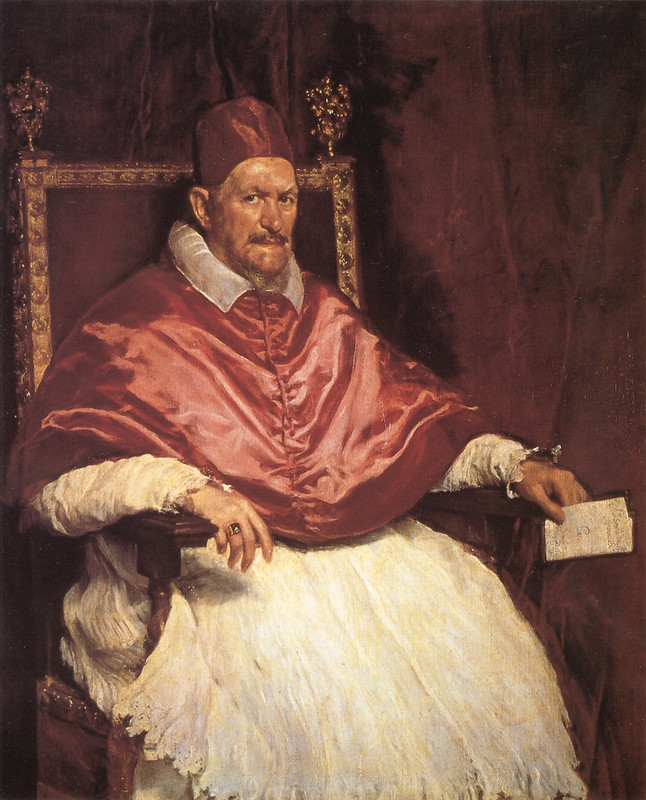
However, for me his second trip to Italy is mostly interesting
because it resulted in his first mirror-in-art – and also his only nude,
the famous
Venus del espejo – which is, by the way, also an example of painting-in-painting:
There are relatively detailed life records describing many works
of Velázquez – when any particular was started, who commissioned it and
how much was paid etc; besides being a painter, Velázquez was also in
charge of certain court property (the paintings and other art work, but
also furniture, valuable tableware, and so one, and kept detailed
records of these items).
A bit suspiciously, therefore, that there no records related to this
work, and we even don’t know who is depicted here. That inevitably
resulted in speculations that she was not just a ‘model, but a mistress
of the painter in Italy. There are also no data on the actual process of
painting, i.e., whether it was a real sitting or a work created from
memory.
This later aspect is important, because Velázquez – similar to many
other painters depicting mirrors – made a typical mistake, known as the
Venus Effect (the
article about this subject on wikipedia is illustrated by this very
painting, though historically speaking it was Titian who made the first
‘wrong’ Venus with mirror).
In essence, if it would be a real scene, we wouldn’t be able to see
the face of the woman – or, rather, if we see the face, it means that
she is not able to see herself in this mirror. Which in turn means that
the cupid is not there to show to the goddess her beauty, but to aid her
to play the (visual) tricks with us.
Speaking about modernity, and perception of art, Foucault should have better used this painting, not
Meninas,
for his far-fetching conclusions, because it does represent a very
clever inter-play with the viewer, including his ‘placement’ into a
certain position (if not physical, then social).
The history of the work is quite perplex (I told that the date of its
conception is unknown, but neither is neither is the date of finish –
according to one version,Velázquez brought it back from Italy to Spain
deliberately unfinished, to avoid and conflicts with the church
authorities. In any case, the work was eventually completed, and was in
the royal collection until the beginning of the 19th century, when it
was brought to England, to the so called Rokeby Park, which also lead to
another name for the painting, the
Rokeby Venus.
Later in 1656 Velázquez will create his Meninas (see above the
debates about this work, to which I only wanted to add this one
dimension, of a painting-in-painting aspect).
Shortly before his death in 1660 Velázquez will create another
beautiful and very enigmatic work, yet another example
of painting-in-painting – though this time he even exceeded himself,
creating the third layer, so it is painting-in-painting-in-painting:
The work is called
Arachne (1659), and depicts a group of the weaving women (although also an allusion to the Greek mythological figure of
Arachne
who challenged Athena, lost and was transformed into a spider). As a
backdrop of this scene the painter used another painting, which in turn
depict a tapestry.
As a way of conclusion
When I write ‘actually’ or ‘in fact’ in relation to the content of
the painting, I am actually not in search of any final truth or the
real-real version. I think my motivation is to multiply rather than
reduce meanings; the more the merrier kind of logic. I don’t really
consider Foucault ‘wrong’, or Snyder ‘right’ in their debates about
Meninas. They
all certain valid points, and thus right to exist, but what I really
like is when these multiple viewpoints also lead to the emergence of
even more complex frameworks and considerations (and
evenconsiderations-in-considerations).
Basically, that’s why I even started not from the work itself, but
from its various re-interpretations and remakes, and then
reinterpretations of reinterpretations, as in the case of David
Hamilton’s recycling of Picasso’s version of
Meninas.
By the way, the vase majority of these
re-interpretations that I gathered
point that the mirror was one of the least interesting object for the
authors. It is there, most often, but the key focusing triangle is
invariably The Girl – Her Skirt – and The Dog.
One of my favorite remakes is the version by Martín La Spina, called
Meninas detras del espejo
(Meninas behind a mirror) (2004) where in the mirror we see the
very Velázquez. I think he deserved this place more than anybody else.
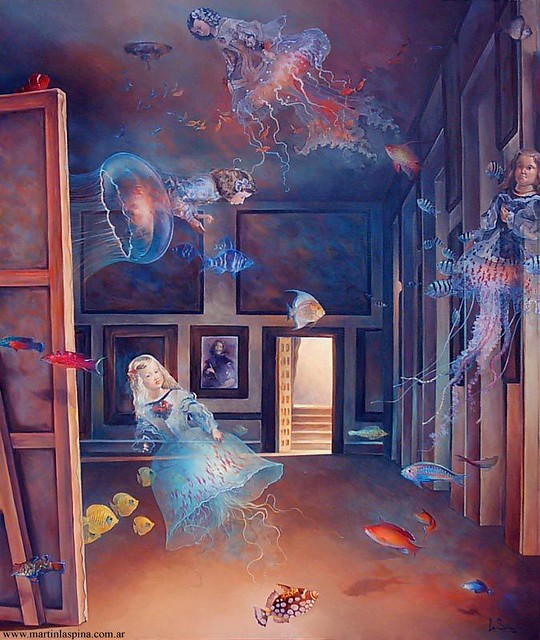



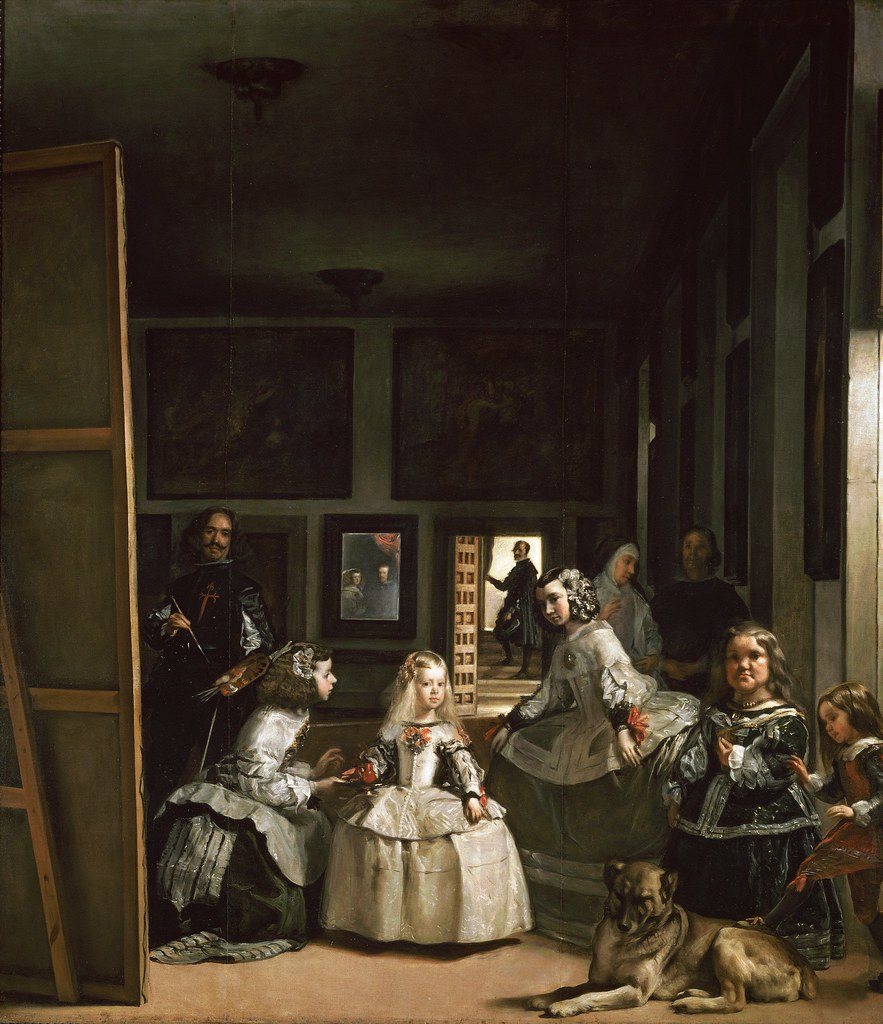










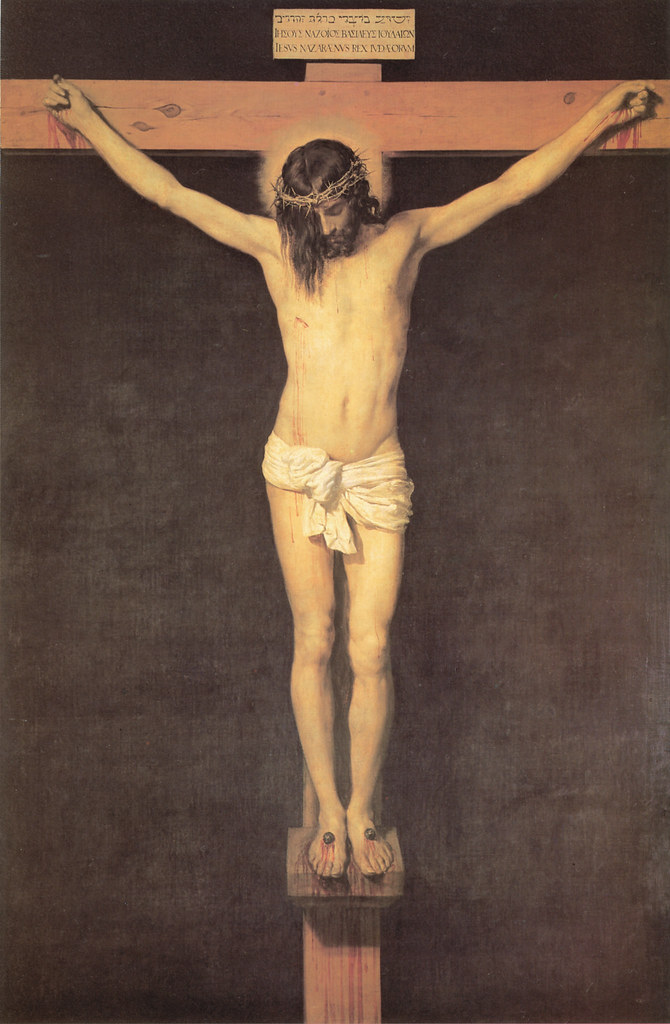













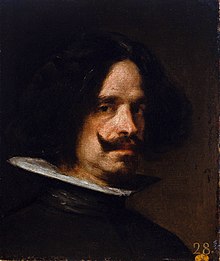


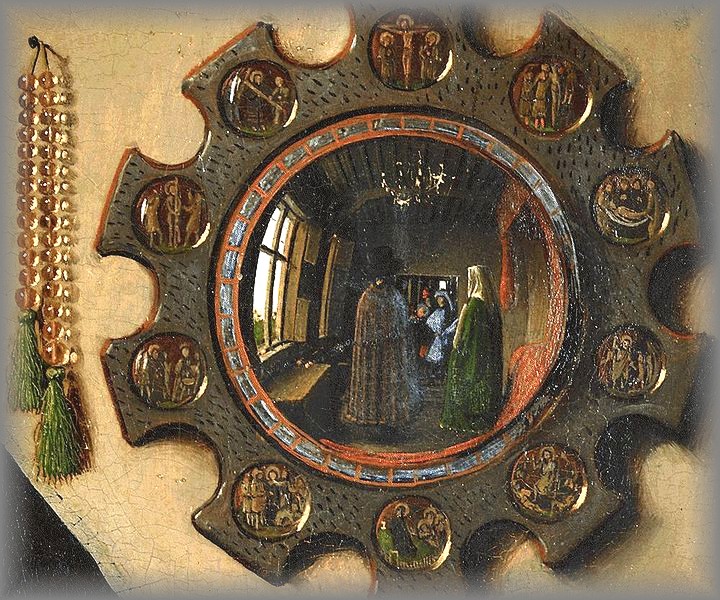



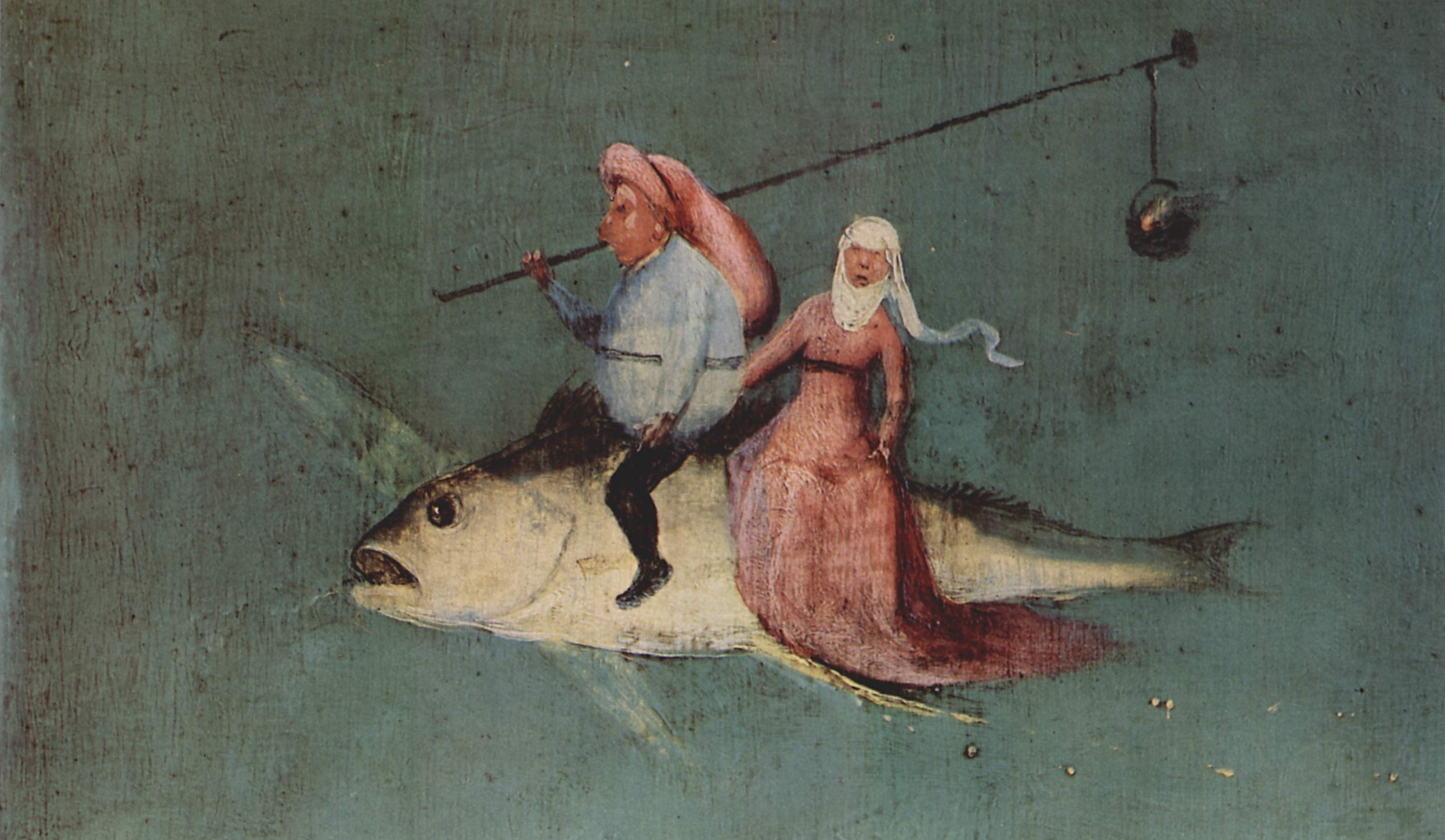




 Daniela Macorin
Daniela Macorin

